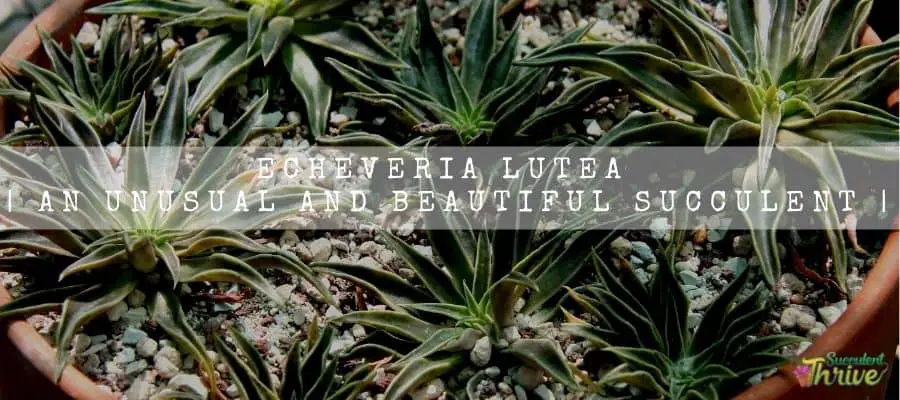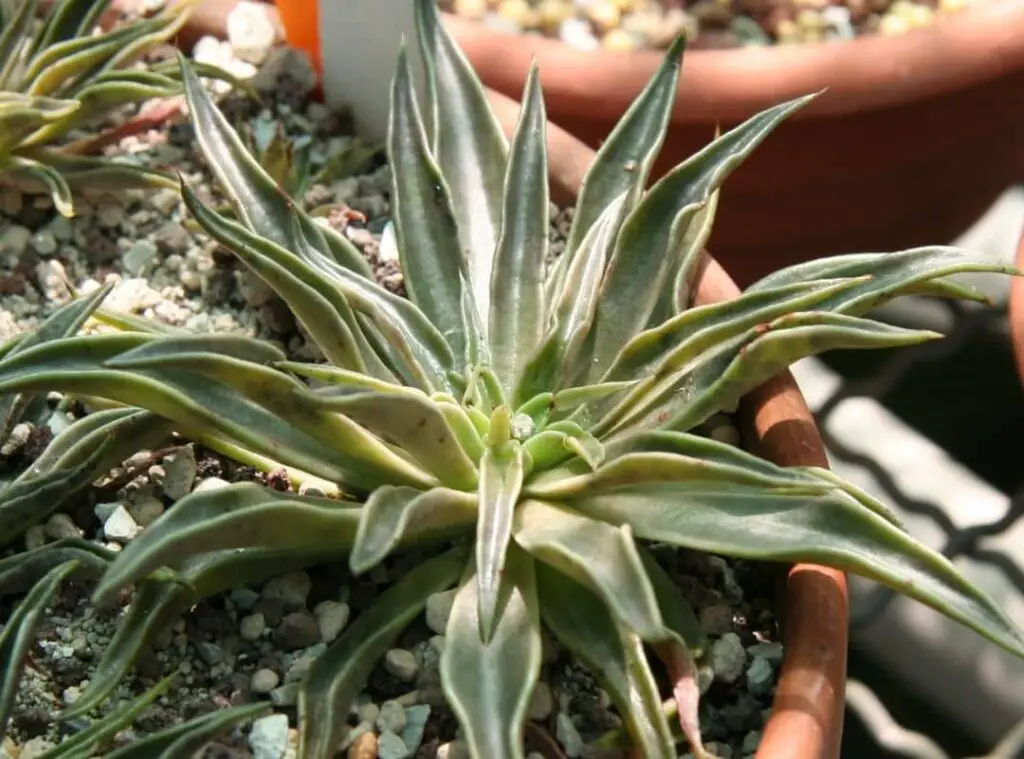Echeveria lutea is a spectacular plant in the succulent world. They are small yet so graceful in their looks.
They go by the common name Yellow Echeveria. They usually grow as solitary plants and the main highlight of the Echeveria lutea plants is that their triangular shaped dark green to light blue colored leaves.
Echeveria lutea are endemic plants in Mexico. This article is about how to look after them well and how to propagate them and multiply them. So, keep reading this article to enhance your knowledge on the same.

How do I identify echeveria lutea?
Echeveria lutea are small plants which always grow as solitary plants. They would usually be 20 cm in width and 15 cm in length when they are fully grown.
They would form leaves margins in reddish purple in color when they are properly stressed. Further it would form a deep hollow in their leaves when they are properly stressed.
Further their lower surface will form in a face up manner in green. That characteristic gives Echeveria lutea a unique bi colored appearance.
You could spot this feature when they go through water stress or light stress properly. If you water them regularly, they will remain in the usually green color.
Furthermore, they would produce blooms in summer, and you could spot them forming right well above the foliage on a stalk.
The color of the flowers is yellow. You may use these characteristics to identify these plants.
Size of the plant
As aforesaid they would be 20 cm wide and 15 cm long.
Growth rate
They grow at a moderate growth rate.
One look care guide
| Botanical Name | Echeveria lutea |
| Common Name | Yellow Echeveria |
| Plant Type | Succulent |
| Mature Size | 20 cm wide and 15 cm long |
| Sun Exposure | Full Sunlight to partial sunlight |
| Soil Type | Well-draining sandy |
| Soil pH | Around 6.0 |
| Bloom Time | Summer |
| Flower Color | Yellow |
| Hardiness Zones | USDA hardiness zones 9b-11b -3.9°C (25°F) |
| Native Area | Mexico |
| Toxicity | Non Toxic |
| Average price | $ 4 |
How do you take care of echeveria lutea?
Succulents in general are hardy plants and they can survive with minimum supervision from you. Echeveria lutea is no different to them. These are self-thriving plants and only expect a minimum care treatment from you.
Light Requirement
It is crucial that you expose this plant to full sunlight to partial shade when growing the Echeveria lutea plants.
Those are the optimal conditions for the proper growth of the this plants. Hence, if you want to grow them as indoor plants to grace the indoor landscape, you may grow Echeveria lutea plants closer to a bright sunny window.
Try exposing them to full sunlight for 6 hours and semi shade for the rest of the day. Direct sunlight exposure for Echeveria lutea could be unhealthy.
Hence avoid doing that. If you think your beloved Echeveria lutea plants lack sufficient sunlight, consider supplying them with additional light by placing grow lights.
Temperature and humidity
Echeveria lutea prefers to grow in an average temperature range of 65ºF / 18ºC – 70ºF / 21ºC. On the other hand Echeveria lutea can withstand a winter temperature of 50ºF / 10ºC.
Is it cold hardy?
Echeveria lutea are mildly cold hardy plants.
USDA Hardiness Zone
Echeveria lutea are hardy in USDA hardiness zones 9b-11b -3.9°C (25°F)
Watering Requirement
Echeveria lutea can grow well and healthily, if you manage to look after them. So, watering them properly has a greater significance when looking after these plants well.
They have typical water requirements just like the other succulents. Keep in mind to not leave them exposed in waterlogged conditions for too long as it will be unhealthy for the plant’s growth and for their well-being as well.
Ideally when watering the Echeveria lutea, you should water them deeply and let them wither after that. If you adhere to this method, it will reduce the risk of any potential over watering.

Soil Requirement Type / pH
Echeveria lutea optimal growth would be beneficial if you provide them with a potting medium which has an excellent drainage.
Ideal pH of the soil mix should be around 6.0 which literally means slightly acidic. Do not go ahead with alkaline soil mixes.
I encourage you to use succulent soil mix or cactus mixes which you can purchase from the garden’s stores.
Alternatively, you could use an all-purpose potting mix and add sand at equal parts to make a well-draining soil mix to grow these plants.
The purpose of using a well-draining soil mix to avoid retaining any excess moisture in the potting medium.
Pot size Potting and Repotting
Select a terracotta pot or a clay pot to grow the Echeveria lutea plants since they would be beneficial in evaporating the water faster in the pot.
Apart from that, check whether your container or the pot has at least one draining hole which will allow the excess moisture to move through.
In terms of repotting the Echeveria lutea plants, keep in mind that you do not need to do it frequently. Instead, you may do it only if it is essential only.
Before proceeding with repotting, ensure that the soil mix is dry and only then start the proceedings.
All you need to do is to remove the plant and knock away the older soil around the roots. Next you could plant them in a fresh pot in which you have filled with a free draining soil mix.
When you transplant ensure that you bury the roots in the same depth like it was previously grown in. Suspend watering them for a week or two and then water them.
Where to Plant
Plant the Echeveria lutea in a place where they can gain adequate sunlight levels be it a garden you grow them or indoors.
In addition to this requirement, they prefer warmer temperatures to thrive well. If you are someone who lives in a much colder environment, the best is to bring them indoors to protect the plants from those unhealthy conditions.
If you grow them as houseplants, you need to go ahead with porous pots as they are healthy for the optimal growth of the Echeveria lutea plants.
Fertilizer and time of year
Try using a controlled release fertilizer to feed the Echeveria lutea plants. The right season to feed them would be the beginning of their actively growing season.
If you want to use a liquid solution, you could apply them every week when they are actively growing.
Dormancy
Echeveria lutea dormancy falls in the winter season. During their dormancy, suspend feeding them and watering them too.
Can be toxic to pets
Echeverias in general are not toxic.
Common bugs and illnesses
Echeveria lutea resists all pest attacks and disease problems. Having said that, they may come across mealybug attacks if you do not keep the plant clean and do not remove the dead leaves from the plants.
Those dead leaves would be quite attractive towards the other pests and would make the plants more prone towards the other fungal infections.
Special Care tips
Echeveria lutea can thrive on their own. However, you should make sure that you are watering them properly and expose them to sufficient sunlight levels too.
How to propagate echeveria lutea
You may use the Echeveria lutea leaves, cuttings and their seeds to propagate the Echeveria lutea and you could continue with the general practices when doing them.
Echeveria lutea plant benefits
They would be great picks for indoor gardening. Furthermore, you could use them for rock gardens as well.
Finally
Trust you found this article helpful for you to enhance your knowledge on how to look after them well. Happy gardening with Echeveria lutea plants.
Read Next : Echeveria Chihuahuaensis Variegated | Learn About These Small Beauties Echeveria Laui | What Do You Know About This Beautiful Succulent ? Echeveria Ice Green | We Give14 Rock Solid Care Facts |
